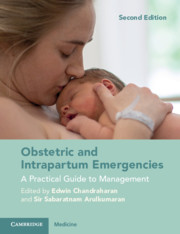Book contents
- Obstetric and Intrapartum Emergencies
- Obstetric and Intrapartum Emergencies
- Copyright page
- Contents
- Contributors
- Preface
- Preface to the First Edition
- Acknowledgements
- Section 1 General Principles
- Chapter 1 Anatomical and Physiological Changes in Pregnancy
- Chapter 2 Principles of Resuscitation for ‘Maternal Collapse’ During Pregnancy, Labour and Postpartum
- Section 2 Algorithms for Management of the Top Five ‘Direct Killers’
- Section 3 Intrapartum Emergencies
- Section 4 Postpartum Emergencies
- Section 5 Medical and Surgical Emergencies During Pregnancy
- Section 6 Anaesthetic Emergencies During Pregnancy
- Section 7 Neonatal Emergencies and the Management of Immediate Neonatal Problems
- Section 8 Management of Anticipated and Non-anticipated Emergencies in Pregnancy
- Section 9 Setting-Up Skills and Drills Training in Maternity Services and Reducing Avoidable Harm
- Index
- References
Chapter 1 - Anatomical and Physiological Changes in Pregnancy
Impact on Emergency Care
from Section 1 - General Principles
Published online by Cambridge University Press: 06 May 2021
- Obstetric and Intrapartum Emergencies
- Obstetric and Intrapartum Emergencies
- Copyright page
- Contents
- Contributors
- Preface
- Preface to the First Edition
- Acknowledgements
- Section 1 General Principles
- Chapter 1 Anatomical and Physiological Changes in Pregnancy
- Chapter 2 Principles of Resuscitation for ‘Maternal Collapse’ During Pregnancy, Labour and Postpartum
- Section 2 Algorithms for Management of the Top Five ‘Direct Killers’
- Section 3 Intrapartum Emergencies
- Section 4 Postpartum Emergencies
- Section 5 Medical and Surgical Emergencies During Pregnancy
- Section 6 Anaesthetic Emergencies During Pregnancy
- Section 7 Neonatal Emergencies and the Management of Immediate Neonatal Problems
- Section 8 Management of Anticipated and Non-anticipated Emergencies in Pregnancy
- Section 9 Setting-Up Skills and Drills Training in Maternity Services and Reducing Avoidable Harm
- Index
- References
Summary
There is an overall increase in plasma, red blood cells (RBCs) and total blood volume. Plasma volume increases by 15% during the first trimester; accelerates in the second trimester; peaks at around 32 weeks, reaching up to 50% above non-pregnant levels; and stays elevated until term. It returns to non-pregnant levels by 6 days post-delivery. There is often a sharp rise of up to 1 litre in plasma volume within the maternal circulation at 24 hours after delivery.
- Type
- Chapter
- Information
- Obstetric and Intrapartum EmergenciesA Practical Guide to Management, pp. 1 - 9Publisher: Cambridge University PressPrint publication year: 2021



